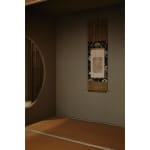Priest Manzei, a Piece from the Picture Scroll of Thirty-six Master Priest-Poets
Ink and light color on paper, hanging scroll
Inscribed with Manzei’s waka poem
Double boxed
Mid-14th century
28.3 x 19.3 cm
132 x 38 cm (overall)
Inscribed with Manzei’s waka poem
Double boxed
Mid-14th century
28.3 x 19.3 cm
132 x 38 cm (overall)
Further images
Provenance
Collection of Sugawara Tsusai (1894-1981)Exhibitions
Kamakura jidai bijutsu kogei meiho ten. Kamakura: Kamakura Kokuho kan Museum, 1946.Literature
Kokka no. 661. Tokyo: Kokkasha, 1947.
This work depicts the Nara-period priest Manzei, who was a highly competent government official and became a priest when the abdicated Empress Gemmei fell ill. Adopting the name Manzei, he composed many poems, seven of which are included in Man’yoshu (Collection of Ten Thousand Leaves). This poem also appears in Man’yoshu though with slight variations; the Man’yoshu version uses somewhat simpler phrasing, which is helpful in interpreting this work.
This mounted piece is the only depiction of Manzei that remains today. Originally it belonged to the Thirty-six Immortal Buddhist Poets compiled by the Shingon monk Eikai in 1347. In addition to this Manzei portrait, we know of four poets featured in a surviving scroll fragment, which includes the introduction to the compilation, as well as twelve more poets from other surviving segments. We can see the entire Thirty-six Immortal Buddhist Poets from a miniature by Kano Tsunenobu (1636–1713) in the Tokyo University of Arts Collection. According to the art historian Umezu Jiro, the images derive from portraits of high priests and so-called “immortal poets,” and the twelve images are taken from the Illustrated Poetry Contest of Figures from Different Periods (Jidai fudo utaawase emaki). The art historian Tsuchiya Takahiro subsequently reported on a copy of Thirty-six Immortal Buddhist Poets in the Tokyo National Museum Collection, which is much closer to the original. Thus, the specific connection between the Thirty-six Immortal Buddhist Poets and the high-priest portraits and that between the Thirty-six Immortal Buddhist Poets and the Illustrated Poetry Contest were ascertained. However, we know of no other portraits of Manzei nor is he present in the Illustrated Poetry Contest, so we are unable to identify the source for this image could have been.
At the end of his miniature scroll, Tsunenobu wrote, “This is in the Tosa style, or perhaps by female hands.” This comment was deemed “a misjudgment” (Umezu) and “difficult to concur with” (Mori). This dynamic, powerful hand is definitely far from being ‘Tosa style’ or by ‘female hands.’ With the broad sweeping lines of the robe, the piece looks relaxed, even artless. “A monk dedicated to copying the Buddhist image and skilled at painting” (Mori) seems a fitting appraisal. As to whether this is an original piece or a copy, the latest line of thinking has it that “This is the original piece created by Eikai, or the closest copy of it” (Tsuchiya).
This mounted piece is the only depiction of Manzei that remains today. Originally it belonged to the Thirty-six Immortal Buddhist Poets compiled by the Shingon monk Eikai in 1347. In addition to this Manzei portrait, we know of four poets featured in a surviving scroll fragment, which includes the introduction to the compilation, as well as twelve more poets from other surviving segments. We can see the entire Thirty-six Immortal Buddhist Poets from a miniature by Kano Tsunenobu (1636–1713) in the Tokyo University of Arts Collection. According to the art historian Umezu Jiro, the images derive from portraits of high priests and so-called “immortal poets,” and the twelve images are taken from the Illustrated Poetry Contest of Figures from Different Periods (Jidai fudo utaawase emaki). The art historian Tsuchiya Takahiro subsequently reported on a copy of Thirty-six Immortal Buddhist Poets in the Tokyo National Museum Collection, which is much closer to the original. Thus, the specific connection between the Thirty-six Immortal Buddhist Poets and the high-priest portraits and that between the Thirty-six Immortal Buddhist Poets and the Illustrated Poetry Contest were ascertained. However, we know of no other portraits of Manzei nor is he present in the Illustrated Poetry Contest, so we are unable to identify the source for this image could have been.
At the end of his miniature scroll, Tsunenobu wrote, “This is in the Tosa style, or perhaps by female hands.” This comment was deemed “a misjudgment” (Umezu) and “difficult to concur with” (Mori). This dynamic, powerful hand is definitely far from being ‘Tosa style’ or by ‘female hands.’ With the broad sweeping lines of the robe, the piece looks relaxed, even artless. “A monk dedicated to copying the Buddhist image and skilled at painting” (Mori) seems a fitting appraisal. As to whether this is an original piece or a copy, the latest line of thinking has it that “This is the original piece created by Eikai, or the closest copy of it” (Tsuchiya).







